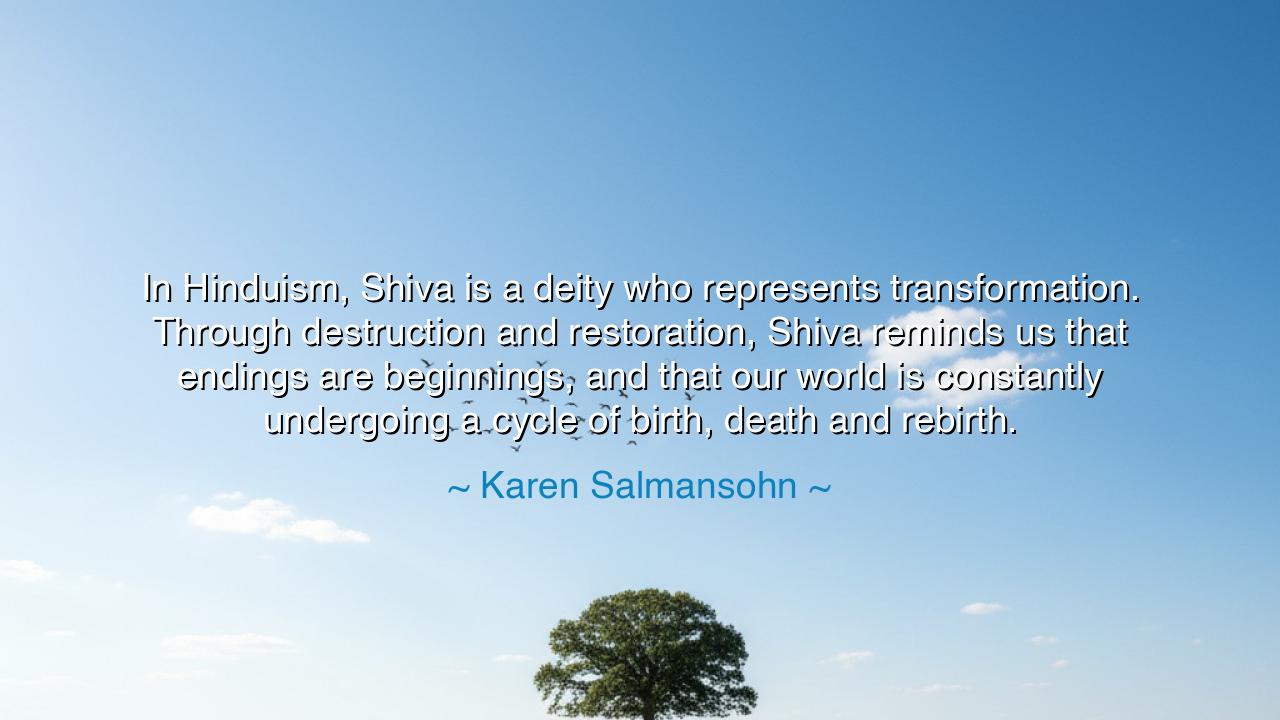
In Hinduism, Shiva is a deity who represents transformation.
In Hinduism, Shiva is a deity who represents transformation. Through destruction and restoration, Shiva reminds us that endings are beginnings, and that our world is constantly undergoing a cycle of birth, death and rebirth.






In the luminous words of Karen Salmansohn, we find an echo of one of the oldest truths known to humankind: “In Hinduism, Shiva is a deity who represents transformation. Through destruction and restoration, Shiva reminds us that endings are beginnings, and that our world is constantly undergoing a cycle of birth, death, and rebirth.” These words are not mere reflection—they are revelation. They speak of the eternal rhythm that governs all existence, a truth that the sages of ancient India carved into the very soul of their philosophy: that life is cyclical, not linear; that even in ruin, the seed of renewal is sown; that every ending whispers of a new dawn.
In the sacred tradition of Hinduism, Shiva stands as the third aspect of the Trimurti—the divine trinity of Brahma the Creator, Vishnu the Preserver, and Shiva the Destroyer. Yet to call Shiva merely a destroyer is to misunderstand his essence, for his destruction is not annihilation, but transformation. It is the cleansing fire that clears the field for new life, the storm that restores balance to the world. He is both ascetic and dancer, both cosmic and intimate. Through his dance—the Tandava—the universe is born, sustained, and dissolved. In this dance lies the deepest wisdom of all: that to cling to permanence is to resist the very pulse of the cosmos.
Salmansohn’s words are rooted in this ancient truth. She calls us to see change not as tragedy, but as necessity; not as punishment, but as process. For what is destruction but the breaking of form to release new potential? The fallen leaf becomes soil. The burned forest makes way for fresh growth. The ending of one love, one dream, one chapter, prepares the heart for another. In the teachings of the ancients, Shiva destroys illusion, not life; he dismantles attachment, not being. His dance is both beautiful and terrible, yet always sacred—for through it, the universe breathes anew.
Consider the story of the ancient city of Pompeii, buried in fire and ash by the eruption of Mount Vesuvius. For centuries, it lay entombed, a symbol of catastrophe and death. Yet when it was uncovered, it became a bridge across time—a rebirth of memory and history. The destruction that once seemed final became, in the end, an act of preservation. From the ashes, humanity learned about itself—its art, its rituals, its resilience. In this, we see Shiva’s principle alive in history: that destruction, when seen through the lens of wisdom, is not the end, but the transformation of form into knowledge, and of sorrow into strength.
The ancients taught that life and death are not enemies, but lovers in eternal embrace. Without death, there can be no renewal; without letting go, there can be no rebirth. Shiva is the embodiment of this paradox. In meditation, he represents stillness; in dance, motion; in destruction, creation. To understand him is to understand that even our own suffering, our losses and endings, are not voids but gateways—pathways through which we are remade. Thus, when Salmansohn speaks of Shiva’s reminder that “endings are beginnings,” she invites us to look upon our broken moments with reverence, for within every collapse lies the quiet hum of rebirth.
We see this truth in the lives of the great. When Mahatma Gandhi was struck down, it seemed as though India’s light had gone out. Yet his death became the birth of a movement, his silence louder than any voice. When the Buddha left his princely life behind, that act of renunciation—his destruction of comfort and illusion—became the awakening of wisdom for millions. So it is with all who dare to transform: what is lost in one form returns in another, purified, expanded, eternal.
So, my child of tomorrow, take this lesson from Shiva, the eternal transformer: do not fear the breaking of your world. Do not cling so tightly to what is passing that you forget what is being born. When change comes—as it always does—welcome it as the sacred fire that renews your soul. If your heart is shattered, let its fragments become seeds. If your life burns down, build again from the ashes with clearer purpose and gentler hands. For you, too, carry Shiva within you—the power to destroy illusion, to restore balance, to transform pain into awakening.
And remember always the eternal rhythm that Salmansohn so beautifully captures: life does not end—it turns. The river flows into the sea, the dusk becomes dawn, and the heart that breaks today will beat again tomorrow. Shiva’s dance continues within and around you, and through it, the universe keeps its promise—that every ending is but the beginning of another life.






AAdministratorAdministrator
Welcome, honored guests. Please leave a comment, we will respond soon